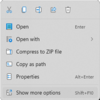Hi, and back again..
I want to keep my full Windows 10 backup drive, which is on an hdd, updated periodically.
Windows 11 is running on a cloned ssd.
I'd like to occasionally boot from the Windows 10 hdd just to be able to run the system updates on it.
Can I place the hdd in a usb docking device and boot Win 10 from there and let it do the updates? Will there be any issues since Win 11 is
installed internally on the ssd?
Or do I have to go into the pc and replace the ssd with the hdd?
I want to keep my full Windows 10 backup drive, which is on an hdd, updated periodically.
Windows 11 is running on a cloned ssd.
I'd like to occasionally boot from the Windows 10 hdd just to be able to run the system updates on it.
Can I place the hdd in a usb docking device and boot Win 10 from there and let it do the updates? Will there be any issues since Win 11 is
installed internally on the ssd?
Or do I have to go into the pc and replace the ssd with the hdd?
My Computer
System One
-
- OS
- Windows 11/Linux Mint
- Computer type
- PC/Desktop
- Manufacturer/Model
- Dell Optiplex 960
- CPU
- Intel Core 2 Duo CPU E8400 @ 3.00 GHz x 2
- Memory
- 8 GB
- Graphics Card(s)
- Intel 4 Series Chipset Integrated Graphics Controller
- Monitor(s) Displays
- HP x22LED
- Hard Drives
- Crucial 250 GB SSD, HD 1Tb

















